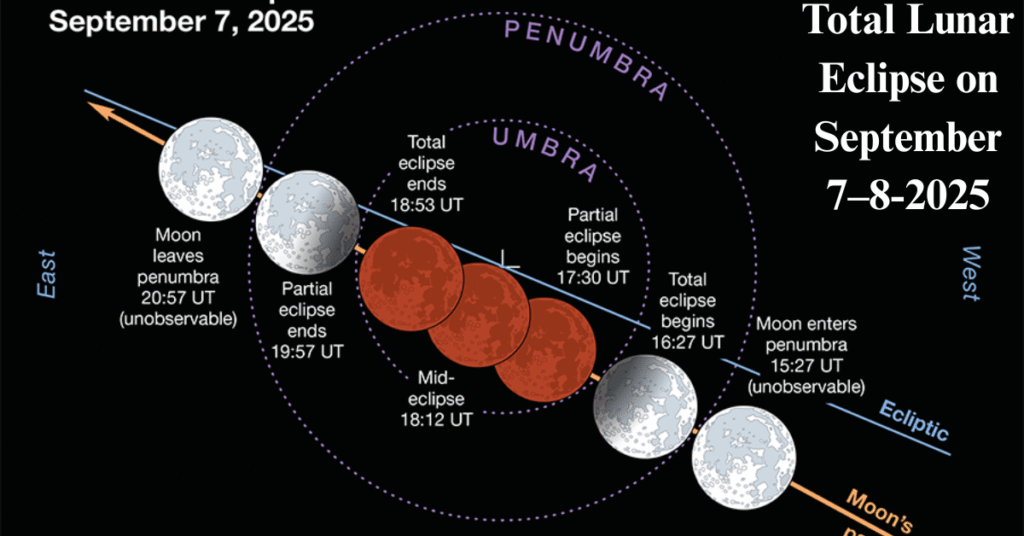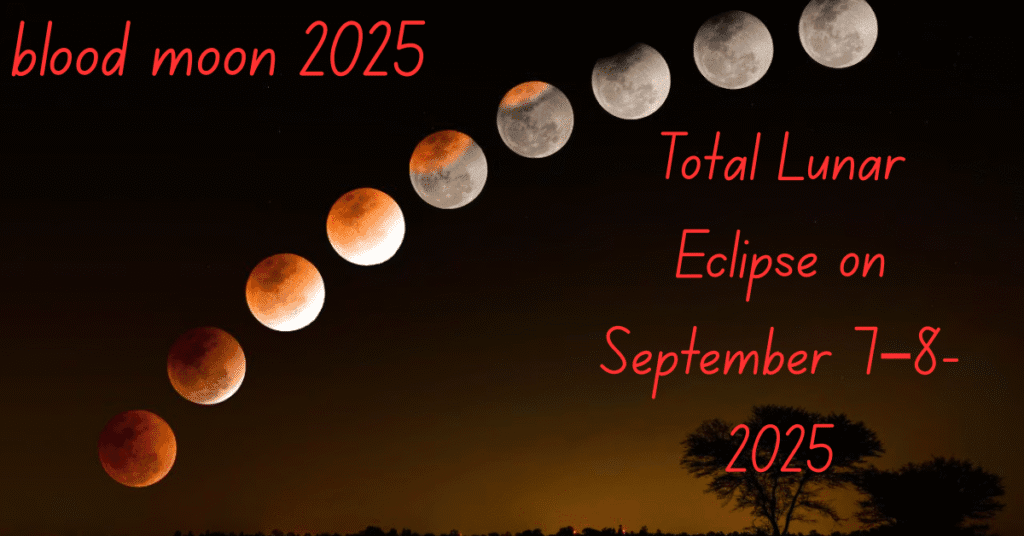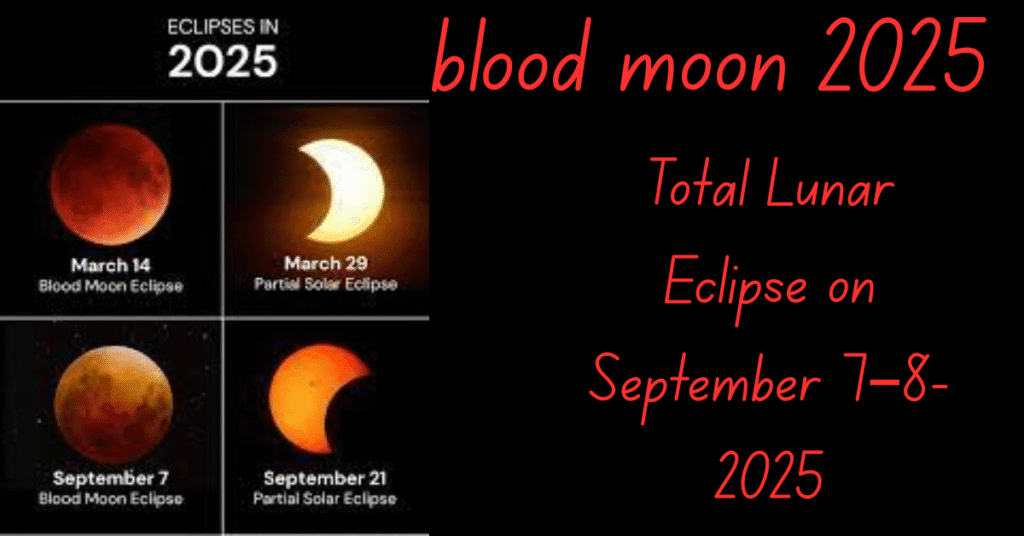
Table of Contents
Total Lunar Eclipse on September 7–8-2025
Total Lunar Eclipse on September 7–8-2025
✨ A Celestial Event You Can’t Afford to Miss!
On the night of September 7 and 8, 2025, skywatchers across the globe will witness one of nature’s most stunning phenomena—a total lunar eclipse, often referred to as a “Blood Moon.” This rare astronomical event will be the longest total lunar eclipse in over three years, with the Moon immersed in Earth’s shadow for more than 5 hours.
Whether you’re an amateur stargazer, astronomy student, or someone seeking a moment of cosmic wonder, this event offers a once-in-a-decade spectacle that you should not miss.

🌌 What Is a Total Lunar Eclipse?
A total lunar eclipse happens when the Earth moves directly between the Sun and the Moon, casting a full shadow (umbra) over the Moon. This blocks direct sunlight from reaching the Moon’s surface. However, some sunlight passes through Earth’s atmosphere, bending and scattering in such a way that only longer wavelengths—reds and oranges—reach the Moon.
This effect, called Rayleigh scattering, is what paints the Moon in hues of red, copper, or deep orange, giving it the nickname: “Blood Moon.”
🕓 Key Timings and Duration of the Eclipse (UTC & Regional)
| Phase | Time (UTC) | Description |
|---|---|---|
| Penumbral Eclipse Begins | 16:14 UTC | Slight dimming starts (barely visible) |
| Partial Eclipse Begins | 17:23 UTC | Moon begins entering Earth’s darker shadow |
| Total Eclipse Begins | 18:30 UTC | Moon fully covered in Earth’s shadow |
| Maximum Eclipse | 19:11 UTC | Blood Moon at its deepest color |
| Total Eclipse Ends | 19:52 UTC | Moon begins exiting full shadow |
| Partial Eclipse Ends | 21:00 UTC | Final stages of partial eclipse |
| Penumbral Eclipse Ends | 22:09 UTC | Moon exits the outer shadow |
⏳ Total duration: 5 hours, 55 minutes
🌑 Totality duration (Blood Moon phase): 1 hour, 22 minutes

🌍 Where Will It Be Visible?
According to Time and Date, this lunar eclipse will be visible to more than 60% of the world’s population.
✅ Best Places for Full Visibility:
- Asia: India, China, Indonesia, Japan, Sri Lanka
- East Africa: Kenya, Tanzania, Ethiopia
- Western Australia
These regions will experience the eclipse from start to finish, including the full blood moon.
🌥️ Partial Visibility Regions:
- Europe: Eastern and Southern regions will see portions
- Central & Southern Africa
- Eastern Australia
Some of these areas will miss either the beginning or end, depending on local moonrise/moonset times.
🇬🇧 Eclipse Timing in the United Kingdom:
- Totality Starts: 19:11 BST (moon still rising)
- Best Viewing Begins: 19:33 BST
- Eclipse Ends: 21:55 BST
Tip: Find a high, east-facing location with an unobstructed view of the horizon for the best experience.
❌ North America: Mostly Missed
Due to daylight and Earth’s rotation:
- USA, Canada, Mexico: No visibility
- Alaska: Only partial penumbral phase visible during moonrise
🔭 Historical & Cultural Significance of Blood Moons
Throughout history, Blood Moons have held deep cultural and spiritual meanings:
- In Mesopotamia, eclipses were seen as omens for kings and empires.
- In ancient India, lunar eclipses were linked with cosmic battles between celestial beings (Rahu and Ketu).
- Native American tribes interpreted Blood Moons as spiritual signs for transformation and balance.
Today, while science has demystified lunar eclipses, the visual drama and rarity of the event continue to fascinate millions across cultures.
🔬 Scientific Insight: Why the Moon Turns Red
The red color occurs because Earth’s atmosphere bends sunlight and filters out the blue spectrum. The red and orange light continues, wrapping around Earth and landing on the Moon’s surface.
This natural filtering process is the same reason sunsets appear red. During an eclipse, it’s as if all the sunsets and sunrises on Earth are reflected simultaneously on the lunar surface!
📸 How to Watch & Capture the Eclipse
You don’t need telescopes or special glasses, but these tips can enhance your viewing experience:
✅ Viewing Tips:
- Check local weather in advance.
- Find a dark area, away from city lights.
- Face East/Southeast (depending on your region).
- Bring binoculars or a telescope for detailed views.
- Carry a chair, warm clothes, snacks, and a camera if you’re out for the evening.
📷 Photography Tips:
- Use a tripod for stability.
- Set long exposure time and low ISO.
- Use manual focus for sharpness.
- Try time-lapse or video to capture the transition.
🔮 Other Must-Watch Celestial Events in 2025
| Event | Date | Details |
|---|---|---|
| Total Solar Eclipse | March 29, 2025 | Visible in Southern Hemisphere |
| Perseid Meteor Shower | Peak on August 12 | One of the best meteor showers of the year |
| Supermoon | October 6, 2025 | Closest full moon of the year |
| Geminid Meteor Shower | Peak on December 14 | High visibility, very bright meteors |
🌟 Final Thoughts: Why This Eclipse Matters
This is more than just a shadow play between celestial bodies—it’s a cosmic performance millions will witness together. The 2025 total lunar eclipse is a rare combination of timing, duration, and beauty.
So wherever you are, step outside on September 7–8, 2025, look up, and let the universe remind you of its magic.
Pro Tip: If clouds obscure your view, consider watching live streams from observatories or space agencies like NASA and ESA.
LunarEclipse2025, #BloodMoon2025, #TotalLunarEclipse, #September2025Eclipse, #MoonEclipse2025, #AstronomicalEvents2025, #Skywatching2025, #BloodMoon, #EclipseVisibility, #LongestLunarEclipse, #MoonTurnsRed, #WatchTheEclipse, #CelestialEvents2025, #EclipseGuide2025, #EclipsePhotographyTips


